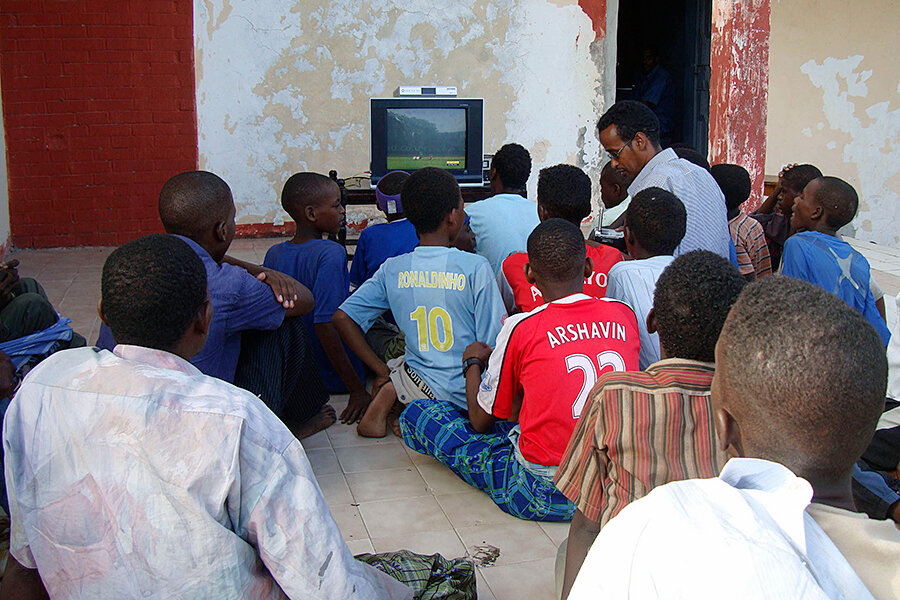What's in a soccer game? For Somalia, a milestone goal.
Loading...
When the final whistle blew in Mogadishu’s Banadir Stadium on late Thursday afternoon, the winner of one of Somalia’s most popular soccer tournaments was neither of the two football clubs on the field.
It was the airwaves.
Thousands around the country tuned in to catch the final of the General Da’ud cup – the first time it has been broadcast live on television in its 43-year existence and a sign that the Horn of Africa nation is continuing its steady process toward recovery after more than two decades of war.
“It is a breakthrough,” Somali Football Federation (SFF) president Abdiqani Said Arab said in a statement before the game. “We had long dreamed of getting our matches watched live — this is almost the realization of our age-old dreams."
The match, which saw the Somali military's Horseed beat their police rivals, highlights Somalia's hard-won military gains against Al Shabab rebels, who were pushed out of Mogadishu in 2011. The peace that has followed – the longest period of stability the capital has experienced since the country fell into a civil war in 1991 – has seen a national government move back into its headquarters, an American embassy reopen its doors in 2015, and a construction boom take off after war damaged 80 percent of the city's structures.
And despite continued Al Shabab attacks in the capital, masses of people feel secure enough to frequent the nightclubs and restaurants where many gather to watch foreign-league soccer games on television.
But Thursday's broadcast holds special significance because it offers a glimpse of the advances Somalia is achieving during this period of stability – from the refurbishing of the stadiums and local leagues to the television station that broadcast the game.
“This will be a test,” said Mr. Arab. “But if we are successful in this endeavor, we will try to get our matches shown live in the months to come.”
A resurgence
Somali football, and the mechanisms surrounding it, has seen a resurgence in recent years, after many of the old elite clubs disbanded after 1991. Jeenyo United FC, for example, one of Somalia’s oldest football clubs, founded in 1948, was revived in 2012.
Sponsorship is on the rise, with local mobile companies and banks, as well as international brands like Coca-Cola, willing to invest in the league. And stadiums like the Banadir, where the cup final was played, are being refurbished. Even foreign players have started coming to play for local teams. This year, more than 17 foreign players joined one of the local teams, Agency France-Presse reports.
“I feel secure,” Kineni Kafunayo Imam, a Ugandan player with Banadir Sports Club, told AFP. "I have never seen any insecurity in Somalia. I move freely and I can go anywhere I want."
Coupled with continued broadcasting of games, the next feat will be bringing the Ocean Stars, the Somali national team, back to play in the national stadium in Mogadishu, a plan officials are working to put in place. For the past decade, the Mogadishu Stadium has been occupied by a combination of troops and rebels. Somali officials requested that its current tenants, the African Union-led peacekeeping mission (AMISOM) vacate the facility soon. AMISOM has been there since Al Shabab fled in 2011.
"[It] is time to get the Somali soccer facilities back to the SFF hands, because our football is now recovering from years of conflicts and all soccer facilities must get back to our hands," Arab said in October when he and Somali Football federation officials visited the stadium.
The Ocean Stars have had to play international “home” matches in neighboring Addis Ababa, including the 2018 World Cup qualifying game they lost to Niger in September. The SFF has made efforts to try get the team play in as many international games as possible, AFP reports:
Somalia has never made it to a major soccer tournament, understandable given its lowly FIFA ranking. It is currently in the bottom six out of more than 200 countries. For years, wrecked by violence at home, Somalia didn't even enter World Cup qualifying. Now, progress is being able to regularly put a team out on the field.
In 2013, FIFA kicked off training programs in Somalia after suspending them since 1991. "Somali youth are good in technique, but the problem that we have is we have been at war for a long time,” Awil Ismail, the technical director of the Somali Football Federation, told Voice of America at the time. “There has been a gap. I hope that the coming years will be better. Because we now have some stability and we have grassroots courses that FIFA has helped us with. So in the future, I hope that we will be one of the best in east Africa.”






